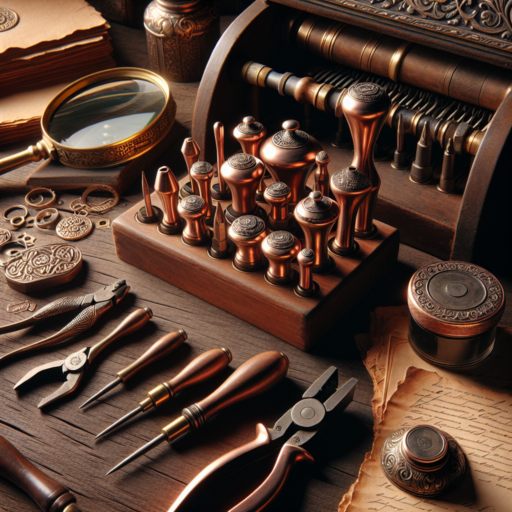What is the technique of a bezel punch set?
The technique of a bezel punch set involves a specific method utilized by jewelers and craft enthusiasts for setting stones securely in metal bezels. This method ensures that the stone is not only held tightly but also allows it to be showcased beautifully without the use of adhesives. The bezel punch set, typically a collection of punches of varying sizes, is designed to fit over the bezel’s edge. By applying a controlled force to the punch, the metal is gently pushed over the stone, creating a clean and secure setting.
Using the bezel punch set requires a combination of precision and finesse. It begins with selecting the appropriate punch size that matches the bezel’s diameter. The bezel itself must be properly prepared, ensuring it is of the correct height and thickness to encase the stone snugly. After placing the stone in the bezel, the chosen punch is positioned on top of the metal’s edge. With a hammer or a mallet, the crafter applies light taps to the punch, gradually pressing the metal over the gemstone. This process may be repeated around the circumference of the bezel to ensure the metal is evenly folded over the stone, securing it in place.
One of the key aspects of mastering the bezel punch set technique is ensuring the uniform application of force. This ensures that the bezel is not damaged and that the stone is set evenly, preventing any possible movement or fall-out. Furthermore, this technique allows for a high degree of customization in jewelry making, as the bezel can be shaped and textured according to the designer’s artistic vision, enhancing the stone’s natural beauty and the overall aesthetic of the piece.
What is the difference between prong setting and bezel setting?
Understanding the key differences between prong setting and bezel setting in jewelry can greatly influence your choice when selecting a piece, as each setting offers its unique advantages and visual appeals.
Prong setting, arguably the most popular method for engagement rings and fine jewelry, involves metal claws or prongs that hold a stone firmly in place. The number of prongs can vary, typically ranging from four to six, though more intricate designs may use more. The major advantage of a prong setting is its ability to allow maximum light to enter the stone from all angles, thereby enhancing the stone’s brilliance and sparkle. However, while prong settings elevate the stone for prominence and radiance, they also leave more of the stone exposed, which can increase the risk of snagging and potentially damaging the stone or setting.
On the other hand, the bezel setting offers a more secure grasp on the stone. This method encompasses the stone with a metal rim or collar that either partially or completely surrounds the perimeter of the stone. This style is noted for its modern appearance and is particularly valued for its ability to protect the edges of the stone, making it an ideal choice for those with active lifestyles or for securing softer stones prone to chipping. While bezel settings may reduce the amount of light that enters the stone, thereby slightly diminishing its sparkle compared to prong-set stones, they compensate with increased security and a contemporary aesthetic.
Both prong and bezel settings have their merits, and the choice between them often comes down to personal preference regarding style, lifestyle considerations, and the type of stone being set. Prong settings celebrate the stone’s brilliance, making them a favorite for showcasing larger, high-quality gems, whereas bezel settings offer a sleek, secure option that highlights the stone’s shape with a unique, modern flair.
What is the bezel setting method?
The bezel setting method is a popular and ancient technique used in jewelry making to secure a gemstone onto a ring, pendant, or other pieces of jewelry. This method involves a metal rim that encircles the parameters of the gemstone, extending slightly above it. The key aspect of this setting is that the metal, which can be made from gold, silver, platinum, or any other metal, is pushed or hammered over the edge of the gemstone, ensuring it is snugly fit and protected. This not only secures the gemstone in place but also adds a sleek and modern look to the jewelry piece.
One of the main advantages of the bezel setting method is the level of security and protection it offers to the gemstone. Unlike prong settings, where the gemstone is held in place by small metal prongs that can easily get caught on clothing or other materials, a bezel setting completely surrounds the stone. This minimizes the risk of it getting scratched, chipped, or falling out. Thus, it is an ideal choice for people with active lifestyles or those who prefer a more secure setting for their valuable gemstones.
Another aspect to consider is the versatility and style the bezel setting introduces. It can accommodate any gemstone shape, making it a favored choice for custom jewelry designs. The clean and minimalistic edge provided by the bezel setting often appeals to those who favor a modern and sophisticated aesthetic. Furthermore, this setting method can make a gemstone appear larger than it actually is due to the metal border that frames it, enhancing its visual impact.
No se han encontrado productos.
How to use a setting punch?
Utilizing a setting punch effectively is instrumental in achieving precise outcomes in various projects, from leatherwork to metal stamping. Mastering the use of a setting punch requires understanding its operation and handling techniques. This guide will illuminate the essential steps and best practices for leveraging this indispensable tool.
Preparation is Key
Begin by securing your material in place. Whether it’s a piece of leather or metal, ensuring it doesn’t move during the punching process is crucial. Use clamps or a sturdy workbench to hold your material firmly. Select the appropriate size of the setting punch based on the size of the hole or impression you aim to create. This preparatory step is pivotal in achieving clean, precise punches.
Executing the Punch
Position the setting punch perpendicularly to the material’s surface to guarantee an even application. Apply steady, firm pressure on the tool’s handle, using a hammer or mallet if necessary for added force. It’s essential to strike squarely to prevent the tool from slipping and to ensure a clean cut. For materials such as metal, it’s advisable to lubricate the punch tip to minimize friction and wear. Patience and control during this phase significantly affect the quality of the outcome.
After completing the punch, inspect the material for any burrs or rough edges. If necessary, use a file or sandpaper to smooth the area, enhancing the finish of your project. Regular maintenance of your setting punch, including cleaning and sharpening the tip, will extend its lifespan and ensure the preciseness of each punch.



